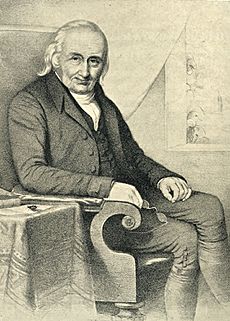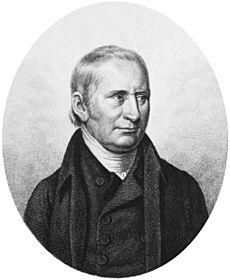William Kirby (entomologist) facts for kids
Quick facts for kids
William Kirby
|
|
|---|---|

Lithograph by T.H. Maguire
|
|
| Born | 19 September 1759 |
| Died | 4 July 1850 (aged 90) Barham, Suffolk, England
|
| Citizenship | England |
| Alma mater | Cambridge University |
| Known for | "Founder of Entomology" |
| Awards | FRS |
| Scientific career | |
| Fields | Entomology |
| Institutions | Ipswich Museum: Entomological Society of London: Linnean Society |
| Author abbrev. (zoology) | Kirby |
William Kirby (born September 19, 1759 – died July 4, 1850) was an important English scientist. He studied entomology, which is the study of insects. He was also a church minister, known as a "parson-naturalist" because he combined his religious duties with his love for nature.
Kirby was a founding member of the Linnean Society and a Fellow of the Royal Society. He wrote a famous four-volume book called Introduction to Entomology with William Spence. This book taught many people about insects.
Contents
Early Life and Studies
William Kirby was born in Witnesham, Suffolk, England, on September 19, 1759. His grandfather, John Kirby, was a famous writer about Suffolk. His uncle, Joshua Kirby, was an artist and a friend of the painter Thomas Gainsborough.
William Kirby went to Ipswich School and then to Caius College, Cambridge. He finished his studies in 1781. In 1782, he became a church minister. He spent his whole working life in the quiet village of Barham. He worked at the parish church of St Mary's for 68 years.
Discovering Natural History
Kirby became interested in natural history thanks to a friend named Nicholas Gwynn. In 1791, he met Sir James Edward Smith, a famous botanist. Kirby started writing to Smith, asking for advice on how to start a natural history museum in Ipswich.
He made friends with other naturalists like Charles Sutton and Thomas Marsham. They went on long trips together to study nature. Kirby became a leading "parson-naturalist." He was one of the first members of the Linnean Society. In 1793, he gave his first scientific talk about three new types of leeches.
Major Books and Discoveries
Kirby wrote his first big book, Monographia Apum Angliae, in 1802. This book was about the Bees of England. He wrote it for both scientific and religious reasons. He believed that studying nature could help people understand God's work.
This book was the first scientific study of English bees. It made him famous among entomologists in Britain and other countries. He wrote many letters to scientists like Johan Christian Fabricius. Kirby discovered 153 bee species, including Lasioglossum malachurum, right in his own church parish!
Introduction to Entomology
In 1808, Kirby started planning his most famous book, Introduction to Entomology. He worked on this book with his friend William Spence. It was published in four volumes between 1815 and 1826. Kirby did most of the work because Spence was often sick. The book had beautiful pictures drawn by John Curtis. It was so popular that it was printed seven times!
In 1830, Kirby was asked to write a book for the Bridgewater Treatises series. His book was called The History, Habits, and Instincts of Animals and came out in 1835.
Arctic Expeditions
Kirby also helped scientists on important expeditions. With Edward Sabine and J.E. Gray, he wrote about the insects found during Captain William Parry's 1819–1820 trip to the Arctic. This expedition was looking for the North-West Passage.
Later, his friend W.J. Hooker connected him with John Richardson. Kirby then wrote the insect section for the Fauna Boreali-Americana in 1837. This book described animals found during Sir John Franklin's expeditions to North America.
Helping to Start Institutions
William Kirby was very active in starting scientific groups and museums.
In 1827, he helped Henry Denny organize the natural history collections at the Norwich Museum. In 1832, he helped create an early museum in Ipswich. He even gave his own collection of dried plants (a herbarium) and fossils to the museum.
Founding the Entomological Society
With William Spence, Kirby helped to create the Entomological Society of London in 1833. This society is still very important for insect scientists today. Kirby became its Honorary President for life. He gave his own collection of insects, which he had gathered for over 40 years, to the society. Many of these insects were drawn in his scientific papers.
Kirby was also the first President of the Ipswich Museum from 1847 to 1850. He had wanted to start this museum since 1791! He was there for the opening ceremony with other famous scientists like William Buckland. A famous picture of Kirby by T.H. Maguire was made from a painting that is still in the Ipswich Museum today.
Other Works
Besides his famous books, Kirby wrote many scientific papers for journals like the Transactions of the Linnean Society and the Zoological Journal. He also wrote some religious works, including Seven Sermons on our Lords Temptations (1829).
Some of his important works include:
- Kirby, W. & Spence, W., Introduction to Entomology, 4 volumes, (1815–1826).
- Kirby, W., Monographia Apum Angliae; 2 volumes, (1802).
- Kirby, W., On the Power Wisdom and Goodness of God. As Manifested in the Creation of Animals and in Their History, Habits and Instincts; Bridgewater Treatises, W. Pickering, 1835.
- 'A Century of Insects. Including Several New Genera Described from His Cabinet'; Transactions Linnean Society London, 12:375–453 (1818).
- 'The Insects' in J. Richardson, Fauna Boreali-Americana; or the Zoology of the Northern Parts of British America...; Vol. 4, 377 pp. (Norwich, Josiah Fletcher, 1837).
See also
- Earl of Bridgewater for other Bridgewater Treatises
- Apiology
- Thomas Say Father of Entomology in North America


